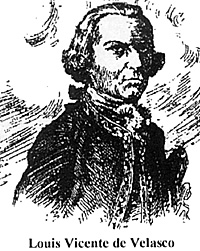 "Since the beginning of this war never has English valour encountered a more constant adversary than Luis de Velasco, governor of El Morro, an enemy worthy of us, whose noble conduct imparts admiration in the very adversary who wishes to subdue him."
"Since the beginning of this war never has English valour encountered a more constant adversary than Luis de Velasco, governor of El Morro, an enemy worthy of us, whose noble conduct imparts admiration in the very adversary who wishes to subdue him."
- --Col. Patrick Mackellar, Chief Engineer Siege of Havana, Cuba; July 1, 1762
Luis Vicente de Velasco was born on February 9, 1711 in the village of Noja on the shore of the Cantabrian sea near Santander in northern Spain to a family of some means and aristocratic lineage. From an early age he developed an interest in naval matters and in pursuing a career in the navy. At the age of 15 lie entered the Armada Real as a midshipman.
The resources of the Armada at this time were stretched in fulfilling its mission of protecting Spain's far-flung possessions from the Mediterranean to the Americas and to the Pacific. Adversaries abounded ranging from Barbary pirates to the Royal Navy. The period between the conclusion of the War of the Spanish Succession in 1714 and the Seven Years War (1756-1763), teemed with opportunities for a young Spanish naval officer to hone his sailing and combat skills and to demonstrate courage, initiative and intelligence under circumstances that would advance his career.
Within a year the young midshipman received his baptism by fire during the second siege of Gibraltar by Spain in 1727 as a part of the War with England and France of 1727-1729. As an attache to the Duque of Montemar he participated in the naval expedition of 1732 which recaptured Oran (Algeria). The War of Jenkin's Ear (1739-1743) found Velasco already in command of a 30 gun frigate patrolling the trade route between Veracruz, Mexico and Havana, Cuba as part of the Spanish naval buildup intended to counteract British operations in the Antilles and North America against Spanish possessions. For Velasco these were years of feverish activity at sea in grueling patrols and constant convoy duty.
In June of 1742, while cruising between Havana and Matanzas, Cuba, Velasco's frigate sighted a more powerful British frigate followed at some distance by a brig. Sensing an opportunity to seize two prizes by engaging them separately, Velasco closed on the frigate and engaged it at short range in a hot exchange lasting over two hours. Finally narrowing the gap enough to come alongside and grapple the frigate, Velasco led his men onto the enemy decks and, after a bitter fight, obtained its surrender before the brig could come to its assistance. The combat with the frigate had not impaired Velasco's ship and, leaving a prize crew on the frigate, he then gave chase to the brig putting two shots into its hull at waterline.
It too started sinking and soon struck its colors. The ship's boats from Velasco's frigate quickly plied their way to the brig, locked the crew below deck and patched the damage to prevent it from sinking. The frigate and the two prizes then headed for Havana with all the speed that their damaged condition permitted. Although by then the city was jaded to the sight of prizes being towed in by vessels of the Armada or by privateers, Velasco was recognized with particular approval when it was confirmed that the prisoners outnumbered his crew two to one.
The years up to 1754 found Velasco devoted to constant frigate duty, cruising in Caribbean waters on the lookout for enemy vessels and smugglers. As if to confirm that his prior success had not been a fluke, his vigilance again proved fruitful on June 27, 1746, while on patrol off the northern coast of Cuba, when he boarded and captured another British frigate of 36 guns and its 150 man crew.
Twenty eight years of sterling service were rewarded on March 20, 1754 with the command of a ship of the line, Reina(70). Velasco's ship, together with four other men-of-war, four frigates, and two brigs, formed a fleet that was charged with the protection of Havana, then considered the center of Spanish power in the Caribbean and the strongest place in the West Indies. Velasco's posting to Havana would ultimately place him in the limelight in the summer of 1762 when the city became the focus of a struggle for empire between Spain and England.
Luis de Velasco The Siege of Havana, 1762
- Introduction and Background
War Between Spain and England
Plan of Defense and Offense
The Siege
Day of Reckoning
Illustration: Spanish Artillerists 1740 (slow: 76K)
Losses at El Morro: Day by Day 6/22-7/30 1762
Plan of El Morro (slow: 123K)
Contemporary Map of Havana (slow: 142K)
Back to Seven Years War Asso. Journal Vol. XII No. 2 Table of Contents
Back to Seven Years War Asso. Journal List of Issues
Back to Master Magazine List
© Copyright 2001 by James J. Mitchell
This article appears in MagWeb (Magazine Web) on the Internet World Wide Web.
Other military history articles and gaming articles are available at http://www.magweb.com